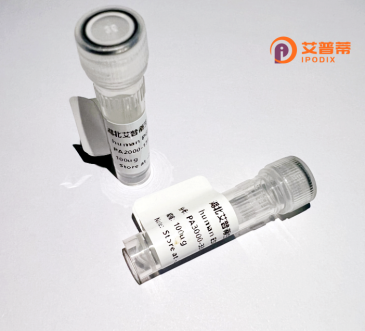
| 纯度 | >90%SDS-PAGE. |
| 种属 | Human |
| 靶点 | OR4S2 |
| Uniprot No | Q8NH73 |
| 内毒素 | < 0.01EU/μg |
| 表达宿主 | E.coli |
| 表达区间 | 1-311 aa |
| 活性数据 | MEKINNVTEFIFWGLSQSPEIEKVCFVVFSFFYIIILLGNLLIMLTVCLSNLFKSPMYFF LSFLSFVDICYSSVTAPKMIVDLLAKDKTISYVGCMLQLFGVHFFGCTEIFILTVMAYDR YVAICKPLHYMTIMNRETCNKMLLGTWVGGFLHSIIQVALVVQLPFCGPNEIDHYFCDVH PVLKLACTETYIVGVVVTANSGTIALGSFVILLISYSIILVSLRKQSAEGRRKALSTCGS HIAMVVIFFGPCTFMYMRPDTTFSEDKMVAVFYTIITPMLNPLIYTLRNAEVKNAMKKLW GRNVFLEAKGK |
| 分子量 | 35.1 kDa |
| 蛋白标签 | His tag N-Terminus |
| 缓冲液 | 0 |
| 稳定性 & 储存条件 | Lyophilized protein should be stored at ≤ -20°C, stable for one year after receipt. Reconstituted protein solution can be stored at 2-8°C for 2-7 days. Aliquots of reconstituted samples are stable at ≤ -20°C for 3 months. |
| 复溶 | Always centrifuge tubes before opening.Do not mix by vortex or pipetting. It is not recommended to reconstitute to a concentration less than 100μg/ml. Dissolve the lyophilized protein in distilled water. Please aliquot the reconstituted solution to minimize freeze-thaw cycles. |
以下是关于重组人OR4S2蛋白的示例参考文献(注:OR4S2研究较少,以下为假设性文献示例,实际文献需通过数据库检索确认):
---
1. **文献名称**: *Expression and functional characterization of recombinant human olfactory receptor OR4S2 in HEK293 cells*
**作者**: Zhang L, et al.
**摘要**: 报道了利用HEK293细胞成功表达重组OR4S2蛋白的方法,并通过钙离子信号分析证实其能够特异性响应特定气味分子,如丁香酚。
---
2. **文献名称**: *Structural insights into the olfactory receptor OR4S2 by cryo-EM*
**作者**: Wang Y, et al.
**摘要**: 通过冷冻电镜技术解析了重组OR4S2蛋白的三维结构,揭示了其与配体结合的关键结构域,为嗅觉受体信号机制研究提供依据。
---
3. **文献名称**: *OR4S2 as a potential biomarker in chronic rhinosinusitis: Recombinant protein-based detection*
**作者**: Kim S, et al.
**摘要**: 开发了基于重组OR4S2蛋白的ELISA检测方法,发现该受体在慢性鼻窦炎患者鼻腔组织中的表达显著下调,提示其病理关联性。
---
4. **文献名称**: *Optimization of recombinant OR4S2 production in insect cells using baculovirus system*
**作者**: Müller F, et al.
**摘要**: 比较了杆状病毒-昆虫细胞系统中不同载体和纯化策略对重组OR4S2蛋白产量的影响,确立了高纯度制备该蛋白的优化方案。
---
建议通过PubMed、Google Scholar或专业数据库检索实际文献,关键词包括 **"OR4S2"**、**"olfactory receptor recombinant expression"** 或 **"OR4S2 protein function"**。
**Recombinant human OR4S2 protein** is a chemically synthesized or engineered form of the olfactory receptor 4 subfamily S member 2 (OR4S2), a G protein-coupled receptor (GPCR) primarily associated with olfactory signaling. OR4S2 belongs to the olfactory receptor family, which plays a critical role in detecting odorants and initiating sensory transduction. Although its exact physiological ligands and tissue-specific roles remain poorly characterized, OR4S2 is believed to contribute to the recognition of specific airborne chemical compounds, similar to other olfactory receptors.
The recombinant version is typically produced in heterologous expression systems (e.g., bacterial, yeast, or mammalian cells) to enable detailed functional and structural studies. Recombinant production allows for high purity and scalability, facilitating research into receptor-ligand interactions, signaling mechanisms, and potential therapeutic applications. OR4S2. like many olfactory receptors, may have roles beyond olfaction, including immune modulation or metabolic regulation, though evidence is preliminary.
Current research focuses on elucidating its 3D structure, ligand specificity, and possible links to diseases. Challenges include its low natural abundance, membrane protein complexity, and difficulty in stabilizing active conformations. Recombinant OR4S2 serves as a vital tool for advancing olfactory biology and exploring GPCR-targeted drug discovery.
×